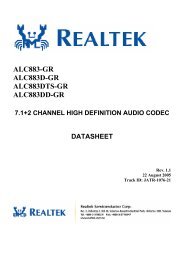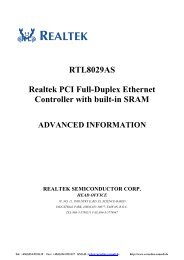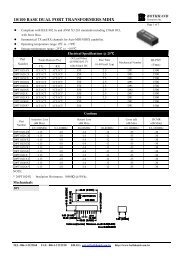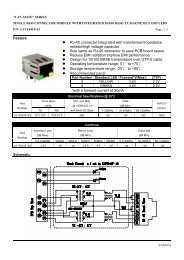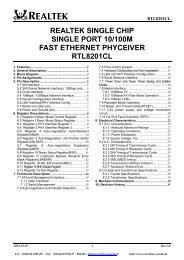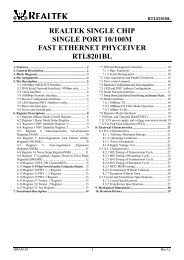realtek single chip 16-port 10/100 ethernet ... - Cornelius-Consult
realtek single chip 16-port 10/100 ethernet ... - Cornelius-Consult
realtek single chip 16-port 10/100 ethernet ... - Cornelius-Consult
Create successful ePaper yourself
Turn your PDF publications into a flip-book with our unique Google optimized e-Paper software.
RTL83<strong>16</strong><br />
6.14 Flow Control<br />
The RTL83<strong>16</strong> sup<strong>port</strong>s IEEE 802.3x full duplex flow control and half duplex back pressure congestion control.<br />
The ability of full duplex flow control is enabled by the ENFDFCTRL pin setting during H/W reset. The IEEE 802.3x flow<br />
control's ability is auto-negotiated between the remote device and the RTL83<strong>16</strong> by writing the flow control ability via MDIO<br />
to external connected PHY.<br />
If ENFDFCTRL is set and the 802.3x pause ability from the auto-negotiation result is enabled, the full duplex 802.3x flow<br />
control function is enabled. Otherwise, the full duplex 802.3x flow control function is disabled. When 802.3x flow control is<br />
enabled, the RTL83<strong>16</strong> will only recognize the 802.3x flow control PAUSE ON/OFF frames with DA="0180C2000001",<br />
type="8808", OP-code="01",PAUSE Time = maximum or zero, and with good CRC.<br />
If a PAUSE frame is received from any PAUSE flow control enabled <strong>port</strong> with DA=0180C2000001, the corresponding <strong>port</strong> of<br />
the RTL83<strong>16</strong> will stop its packet transmission until a PAUSE timer timeout or another PAUSE frame with zero PAUSE time is<br />
received. No 802.3x PAUSE frames received from any <strong>port</strong> will be forwarded by the RTL83<strong>16</strong>.<br />
The RTL83<strong>16</strong> adopts a special half duplex back pressure design, forwarding one packet successfully after 48 force collisions<br />
to prevent the connected repeater from being partitioned due to excessive collisions. The half duplex back pressure flow<br />
control is controlled by EnBKPRS pin strap upon hardware reset.<br />
6.15 Broadcast Storm Filtering Control<br />
The RTL83<strong>16</strong> can enable broadcast storm filtering control by hardware setting of pin ENBRDCTRL. Each <strong>port</strong> will drop<br />
broadcast packets (Destination MAC ID is ff ff ff ff ff ff) after receiving continuous 64 broadcast packets. The counter will be<br />
reset to 0 every 800ms or when receiving any non-broadcast packets (Destination MAC ID is not ff ff ff ff ff ff).<br />
6.<strong>16</strong> Head-Of-Line Blocking Prevention<br />
The RTL83<strong>16</strong> incorporates a simple mechanism to prevent Head-Of-Line blocking problems when flow control is disabled.<br />
When the flow control function is disabled, the RTL83<strong>16</strong> will first check the destination address of the incoming packet. If the<br />
destined <strong>port</strong> is congested, then the RTL83<strong>16</strong> will discard this packet to avoid blocking the next packet which is going to a<br />
non-congested <strong>port</strong>.<br />
6.17 Port Trunking and Load Balance<br />
Port Trunking is the ability to aggregate several <strong>10</strong>/<strong>10</strong>0 Mbps <strong>port</strong>s into a <strong>single</strong> logical link. There are 4 trunk groups<br />
sup<strong>port</strong>ed by the RTL83<strong>16</strong>. Each trunk group comprises 4 fixed physical <strong>port</strong>s. They are simply identified as: Trunk0 =<br />
<strong>port</strong>{0,1,2,3}, Trunk1 = <strong>port</strong>{4,5,6,7}, Trunk2 = <strong>port</strong>{8,9,<strong>10</strong>,11}, Trunk3 = <strong>port</strong>{12,13,14,15} and are individually enabled by<br />
pins ENTRUNK[3:0] during hardware reset. Each trunk sup<strong>port</strong>s a trunking <strong>port</strong> status LED. The LED will be active low<br />
when the trunking function is enabled. If any physical <strong>port</strong> of a trunk group has a link down, then all of the physical <strong>port</strong>s of the<br />
trunk group will be treated as having a link down and the Trunk LED will blink for 250ms ON and 250ms OFF to indicate that<br />
a fault condition has happened on this trunk group.<br />
The RTL83<strong>16</strong> trunking <strong>port</strong> always sends packets over the same link path in the trunk with a given source and destination<br />
MAC address to prevent frames from becoming out of order, but the reverse path may follow a different link. The scheme of<br />
load balance between links in a trunk group is simply determined by an Index[1:0] value that is calculated by the DA and SA<br />
hash algorithm defined as follows.<br />
The DA[0:47] SA[0:47] (order based on serial stream) hashed value Index[1:0] is calculate as below:<br />
Index bit0 = XOR ((bits 47, 45, 43, 41, 39, 37, 35, 33 of DA),<br />
(bits 46, 44, 42, 40, 38, 36, 34, 32 of SA))<br />
Index bit1 = XOR ((bits 47, 45, 43, 41, 39, 37, 35, 33 of SA),<br />
(bits 46, 44, 42, 40, 38, 36, 34, 32 of DA))<br />
2001/11/09 14<br />
Rev.1.72<br />
Tel: +49(0)234-9351135 · Fax: +49(0)234-9351137 E-MAIL: info@cornelius-consult.de http://www.cornelius-consult.de



